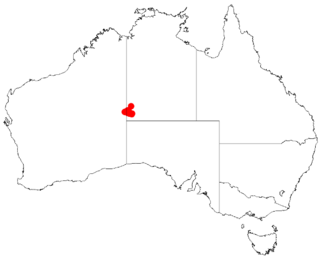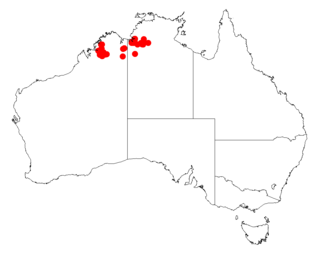
Acacia cremiflora, is a small wattle plant occurring in parts of inland New South Wales. It may be seen growing near Orange and Yerranderie. It was first collected on 15 May 1972. The attractive yellow or cream flowers may appear at any time of the year.

Acacia linifolia, known colloquially as white wattle, or flax wattle, is a species of Acacia native to eastern Australia.

Acacia lachnophylla is a shrub belonging to the genus Acacia and the subgenus Phyllodineae that is endemic to south western Australia.

Acacia lanceolata is a shrub belonging to the genus Acacia and the subgenus Phyllodineae and is endemic to a small area of western Australia.

Acacia pycnocephala is a shrub of the genus Acacia and the subgenus Phyllodineae that is endemic to south western Australia.

Acacia retrorsa is a shrub of the genus Acacia and the subgenus Phyllodineae that is endemic to western Australia
Acacia rhamphophylla, commonly known as Kundip wattle, is a shrub of the genus Acacia and the subgenus Phyllodineae that is endemic to a small area in south western Australia. It is listed as an endangered species according to the Environment Protection and Biodiversity Conservation Act 1999.

Acacia robiniae, commonly known as Robin's wattle, is a shrub of the genus Acacia and the subgenus Phyllodineae that is endemic to south western Australia.

Acacia shuttleworthii is a shrub of the genus Acacia and the subgenus Phyllodineae that is endemic to western Australia.

Acacia sphenophylla is a shrub of the genus Acacia and the subgenus Phyllodineae that is endemic to a small area in western Australia.

Acacia vassalii, commonly known as Vassal's wattle, is a shrub of the genus Acacia and the subgenus Phyllodineae that is endemic to a small area of south western Australia. It is listed as critically endangered with the World Conservation Union, as endangered according to the Environment Protection and Biodiversity Conservation Act 1999 and as rare flora with the Wildlife Conservation Act 1950 in Western Australia.

Acacia auricoma, commonly known as Petermann wattle, Alumaru and Nyalpilintji wattle is a shrub of the genus Acacia and the subgenus Plurinerves. It is native to an area in the Northern Territory and the eastern Goldfields region of Western Australia.

Acacia froggattii is a shrub of the genus Acacia and the subgenus Plurinerves that is endemic to an area in north western Australia

Acacia obesa is a shrub of the genus Acacia and the subgenus Plurinerves that is native to a small area of south western Australia.

Acacia vittata, commonly known as Lake Logue wattle, is a shrub of the genus Acacia and the subgenus Plurinerves that is endemic to a small area in western Australia.

Acacia aureocrinita is a shrub belonging to the genus Acacia and the subgenus Phyllodineae that is native to parts of eastern Australia.

Acacia johnsonii, commonly known as gereera wattle or geereva wattle, is a shrub belonging to the genus Acacia and the subgenus Phyllodineae that is native to parts of eastern Australia.
Acacia lauta, commonly known as Tara wattle, is a shrub of the genus Acacia and the subgenus Phyllodineae that is endemic to north eastern Australia. It is rated as being vulnerable according to the Environment Protection and Biodiversity Conservation Act 1999.

Acacia elongata, also known as swamp wattle or slender wattle, is a shrub of the genus Acacia and the subgenus Plurinerves that is endemic to coastal areas of eastern Australia.

Acacia venulosa, commonly known as veiny wattle or veined wattle, is a shrub of the genus Acacia and the subgenus Plurinerves that is endemic to an area of eastern Australia.


















